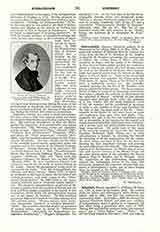

Schubert, FRANZ, composer, b. at Vienna, January 31, 1797; d. there November 19, 1829. He studied under his father, and subsequently under Holzer and Salieri, and in 1807, was first boy soprano in the Lichtenthal choir. In October, 1808, he entered the Imperial Choristers School, and soon gave evidence of extraordinary musical genius as a composer, his first effort being a pianoforte duet, early in 1810. During 1811 and 1812 he produced many instrumental pieces, also a “Salve Regina” and a “Kyrie”. He left the Choir School in November, 1812, and took up work as a schoolmaster in order to avoid conscription. His “First Mass in F” was finished on July 22, 1814, and performed by the Lichtenthal choir under the direction of Holzer. Competent critics have pronounced this mass as perhaps the most wonderful first work by any composer, save in the case of Beethoven’s “Mass in C”. Schubert conducted the second performance at the Augustinian church on October 26, his brother, Ferdinand, presiding at the organ. During the same year he produced a symphony and a “Salve Regina“, as well as some songs and instrumental pieces. His famous “Erl King”, dates from November, 1815, as does his “Mass in G”—wonderful for a boy of eighteen. His compositions for 1816 include a “Salve Regina“, a “Stabat Mater“, a “Tantum Ergo“, and a “Magnificat“, as also two symphonies, and some delightful songs, including the “Wanderer”. He conducted the music at high Mass at the Altlerchenfelder church on Easter Sunday, 1820, and in the same year produced an Easter cantata and an opera. His productivity from 1821 to 1824 was enormous, “Rosamunde” and his “Mass in A flat” being of permanent value. His glorious “Ave Maria” dates from 1825, apropos of which he writes that at the time he was filled with overpowering devotion to the Blessed Virgin. The three Shakesperian songs of 1826 are still of interest. In 1827 he was gratified with a eulogy from the dying Beethoven, whom he visited in his last illness, and whose remains he followed to the grave. He subsequently wrote an opera, a number of songs, and the second part of the “Winterreise”. Early in June, 1827, he was elected a member of the musical society of Vienna, and in 1828, produced his marvelous “Symphony in C”, his “Mass in E flat”, an oratorio, a hymn to the Holy Ghost, a string quartet, a “Tantum Ergo” in E flat, and a lovely “Benedictus” His last appearance in public was on November 3, 1828, when he went to hear his brother’s new “Requiem”: he died a fortnight later, and his obsequies were celebrated in the little Chapel of St. Joseph in Margarethen. On November 21, the body was interred at Wahring, close to the grave of Beethoven, and on December 23 his solemn month’s mind was celebrated in the Augustinian Church, when a “Requiem” by Huttenbrenner was performed. The corpse was reinterred in the central cemetery, Vienna, on September 23, 1888. Schubert produced a phenomenal amount of music, his songs alone numbering about six hundred and three. His compositions came into prominence owing to their advocacy by Liszt, Schumann, and Mendelssohn, but he was in advance of his time and it was not until thirty years after his death that his wonderful genius was fully appreciated. Essaying all forms of composition, he was successful in all, and he may be regarded as second only to Beethoven. In particular, his unfinished symphony, his “Rosamunde” Entracte, his “Mass in E flat”, and about a dozen of his songs are immortal masterpieces.
W. H. GRATTAN-FLOOD

